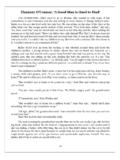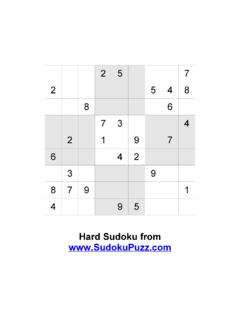Transcription of DuraChrome Hard Chromium Plating
1 Surface Finishing Technology DuraChrome hard Chromium Plating By Eric Svenson - Plating Resources, Inc. Cocoa, Florida, USA 1980, 2006 Table of Contents Chapter 1 Chromium Plating 2 3 4 Chapter 2 Plating LINE 9 Basic ..10 Surface .. 12 Electricity, Generators, Rectifiers And Bus 13 Tanks, Ventilation, Heaters, and Related 18 19 Fixtures, Racking And Stop-Off 22 Cleaning, Activation And 24 Rinsing And Drying 27 The Plating 27 Post- Plating 28 Pollution Chapter 3 QUALITY CONTROL 30 Analysis Bath Chrome Bath 32 Bath Performance Metallurgical 38 Corrosion Resistance 39 12845 W.
2 King St., Unit 108 Cocoa, Florida 32926 PHONE: (321) 632-2435 FAX: (321) 632-8122 E-MAIL: 2 Chapter 1 Chromium Plating Introduction Chromium is bluish-white and lustrous metal that is resistant to corrosion in most atmospheres. Chromium Plating , therefore, is extensively used as a final finishing operation. There are two principal classes of Chromium Plating : "decorative, in which thin coatings serve as a non-tarnishing, durable surface finish; and industrial or " hard " Chromium , where heavy coatings are used to take advantage of the special properties of Chromium , which include resistance to heat, wear, corrosion, erosion, low coefficient of friction and anti galling.
3 Decorative chrome is almost always plated on top of either nickel or a copper and nickel-plated layer. These sub-layers of copper and nickel tend to seal off the substrate so that the micro-cracking chrome deposit does not present corrosion problems. Decorative Chromium deposits are used on such items as automobile bumpers and trim, household appliances, furniture and many other articles that require a bright and aesthetic appearance. The normal thickness for decorative Chromium is in the range of '1 - ". The total deposit including the copper and nickel under-layers is typically " thick.
4 The Dura catalysts used in decorative chrome Plating promote deposition at higher speeds, greatly increase the throwing power of the deposit and activate the sometimes passive nickel under-layer. Chromium Plating baths in general tend to have very poor throwing power and the deposits may appear burned on the edges and may show a lack of Plating or discoloration in the very low current density areas (those areas furthest from the anodes). These problems are overcome with the use of the Dura catalysts, proper racking techniques, anode control and maintenance of optimum bath composition.
5 Our concern for the rest of this paper, however, will be with hard chrome Plating . Chromium is the hardest of the most commonly deposited metals. hard chrome is used as a wear resistant coating not only on steel but also on a wide variety of other metals. hard Chromium differs from decorative Chromium not only because of its use but also because of the difference in deposit thickness. A typical hard chrome deposit is in the range of " - thick. In some cases Thin-Dense hard chrome is used which is typically thick.
6 Other types of specialty hard chrome include Crackless and Multi-Phase deposits which alter and control the microcrack structure. The electro-deposition of hard chrome is a recognized means of prolonging the life of all types of metal parts subjected to wear, friction, abrasion and corrosion. These parts can be protected when newly manufactured, or they can be salvaged when they are worn and would otherwise be scrapped. As an example, it is much less expensive to reclaim worn hydraulic components by rebuilding tolerances with a hard chrome deposit than it is to buy or fabricate the part from scratch.
7 hard Chromium , because it has a low surface energy, is more often deposited on sliding or revolving parts and is, therefore, used on things like engines, pumps, compressors, hydraulic and pneumatic rods, etc. The hard Chromium deposit is also highly resistant to corrosion, and a large number of applications where it is used to protect parts from corrosion are in popular demand. Another attribute of the process is that it is a relatively cold one and can, therefore, be used to impart a very hard surface onto delicate parts without fear of distortion or changing the substrates properties.
8 Thus, it can be regarded as a means of "surface hardening". hard chrome deposits have a hardness range from 56 - 74 depending on the bath type used. Obviously, the higher the (Rockwell C) number the longer the service life will be provided to the component. Deposit hardness is a function of the bath chemistry used. Thus it is best to use a Plating process that provides the highest value. Standard 100:1 sulfate baths only provide a value of 56-60, while the Dura-100 and Dura-3000 baths provide a value of 70-74.
9 A component with a surface hardness exceeding 70 will provide the longest possible service life. 3 Decorative Chromium deposits have the same hardness range as hard chrome. However, industrial Chromium tends to be harder only because of the greater thickness of deposit. A deposit of at least " must be used before the surface entirely reflects the properties of the Chromium metal and not the substrate. All hard chrome deposits, however, have a tendency to reduce the fatigue limit of the part. Shot peening of steels harder than 40 is used prior to Plating to avoid this effect and prolong the life of the part.
10 The Dura baths deposit is compressive and therefore provides less stress that the standard 100:1 sulfate bath which has a tensile deposit. History The commercial process of Chromium Plating resulted principally from the work of C. G. Fink and C. H. Eldridge, in 1923 and 1924. Lieblich also made similar discoveries more or less simultaneously in Germany, but confused them by overemphasis on the supposed importance of the trivalent Chromium also present in the chromic acid-sulfate bath. Udy also discovered a workable process, but his results were not made public until much later.









